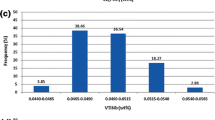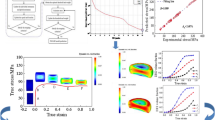Abstract
In the present study, the tensile strength of ferritic and austenitic functionally graded steel produced by electroslag remelting has been modeled by artificial neural networks. Functionally graded steel containing graded layers of ferrite and austenite may be fabricated via diffusion of alloying elements during remelting stage. Vickers microhardness profile of the specimen has been obtained experimentally and modeled with artificial neural networks. To build the model for graded ferritic and austenitic steels, training, testing and validation using respectively 174 and 120 experimental data were conducted. According to the input parameters, in the neural networks model, the Vickers microhardness of each layer was predicted. A good-fit equation that correlates the Vickers microhardness of each layer to its corresponding chemical composition was achieved by the optimized network for both ferritic- and austenitic-graded steels. Afterward, the Vickers microhardness of each layer in functionally graded steels was related to the yield stress of the corresponding layer and by assuming Holloman relation for stress–strain curve of each layer, they were acquired. Finally, by applying the rule of mixtures, tensile strength of functionally graded steels configuration was found through a numerical method. The obtained results from the proposed model are in good agreement with those acquired from the experiments.









Similar content being viewed by others
Change history
25 August 2020
The Editor-in-Chief has retracted this article
References
Bahr HA, Balke H, Fett T, Hofinger I, Kirchhoff G, Munz D, Neubrand A, Semenov AS, Weiss HJ, Yang YY (2003) Cracks in functionally graded materials. Mater Sci Eng, A 362:2–16
Xu H, Yao X, Feng X, Hisen YY (2008) Dynamic stress intensity factors of a semi-infinite crack in an orthotropic functionally graded material. Mech Mater 40:37–47
Tohgo K, Suzuki T, Araki H (2005) Evaluation of r-curve behavior of ceramic-metal functionally graded materials by stable crack growth. Eng Fracture Mech 72:2359–2372
Rousseau CE, Tippur HV (2000) Compositionally graded materials with cracks normal to the elastic gradient. Acta Mater 48(16):4021–4033
Carpenter RD, Liang WW, Paulino GH, Gibeling JC, Munir ZA (1999) Fracture testing and analysis of a layered functionally graded Ti/TiB beam in 3-point bending. Mater Sci Forum 308–311:837–842
Williamson RL, Rabin BH, Drake JT (1993) Finite element analysis of thermal residual stresses at graded ceramic–metal interfaces, Part I: model description and geometrical effects. J Appl Phys 74:1310–1320
Giannakopoulos AE, Suresh S, Finot M, Olsson M (1995) Elastoplastic analysis of thermal cycling: layered materials with compositional gradients. Acta Metallurgica Mater 43:1335–1354
Kolednik O (2000) The yield stress gradient effect in inhomogeneous materials. Int J Solids Struct 37(5):781–808
Aghazadeh Mohandesi J, Shahosseinie MH (2005) Transformation characteristics of functionally graded steels produced by electroslag remelting. Metall Mater Trans A 36A:3471–3476
Aghazadeh Mohandesi J, Shahosseinie MH, Parastar Namin R (2006) Tensile behavior of functionally graded steels produced by electroslag remelting. Metall Mater Trans 37A:2125–2132
Nazari A, Aghazadeh Mohandesi J (2010) Modelling impact resistance of functionally graded steels with crack divider configuration. Mater Sci Technol 26:1377–1383
Nazari A, Aghazadeh Mohandesi J (2009) Impact energy of functionally graded steels with crack divider configuration. J Mater Sci Technol 25(6):847–852
Nazari A, Aghazadeh Mohandesi J, Riahi S (2010) Modeling impact energy of functionally graded steels in crack divider configuration using modified stress-strain curve data. Int J Damage Mech. doi:10.1177/1056789510397073
Nazari A, Aghazadeh Mohandesi J, Hamid Vishkasogheh M, Abedi M (2011) Simulation of impact energy in functionally graded steels. Comput Mater Sci 50:1187–1196
Nazari A, Aghazadeh Mohandesi J (2010) Impact energy of functionally graded steels in crack arrester configuration. J Mater Eng Perform 19:1058–1064
Nazari A, Milani AA, Zakeri M (2011) Modeling ductile to brittle transition temperature of functionally graded steels by artificial neural networks. Comput Mater Sci 50:2028–2037
Nazari A, Milani AA (2011) Ductile to brittle transition temperature of functionally graded steels. Int J Damage Mech. doi:10.1177/1056789511398270
Nazari A, Milani AA (2011) Modeling ductile-to-brittle transition temperature of functionally graded steels by gene expression programming. Int J Damage Mech. doi:10.1177/1056789511406561
Nazari A, Milani AA (2011) Ductile to brittle transition temperature of functionally graded steels with crack arrester configuration. Mater Sci Eng, A 528:3854–3859
Nazari A, Milani AA (2011) Modeling ductile to brittle transition temperature of functionally graded steels by fuzzy logic. J Mater Sci 46:6007–6017
Nazari A, Aghazadeh Mohandesi J, Riahi S (2011) Modified modeling fracture toughness of functionally graded steels in crack divider configuration. Int J Damage Mech 20:811–831
Aghazadeh Mohandesi J, Nazari A, Hamid Vishkasogheh M, Abedi M (2010) Modeling fracture toughness of functionally graded steels in crack divider configuration. Model Simul Mater Sci Eng 18:075007 (13 pp)
Nazari A, Aghazadeh Mohandesi J, Riahi S (2011) Fracture toughness of functionally graded steels. J Mater Eng Perform. doi:10.1007/s11665-011-9945-9
Nazari A, Aghazadeh Mohandesi J, Riahi S (2011) Modeling fracture toughness of functionally graded steels in crack arrester configuration. Comput Mater Sci 50:1578–1586
Nazari A, Aghazadeh Mohandesi J (2011) Modeling tensile strength of oblique layer functionally graded austenitic steel. Comput Mater Sci 50:1425–1431
Nazari A, Riahi S (2010) Effect of layer angle on tensile behavior of oblique layer functionally graded steels. Turkish J Eng Environ Sci 34:17–24
Nazari A, Aghazadeh Mohandesi J, Tavareh S (2011) Microhardness profile prediction of a graded steel by strain gradient plasticity theory. Comput Mater Sci 50:1781–1784
Nazari A, Aghazadeh Mohandesi J, Tavareh S (2011) Modeling tensile strength of austenitic graded steel based on the strain gradient plasticity theory. Comput Mater Sci 50:1791–1794
Nazari A, Mojtahed Najafi SM (2011) Prediction Charpy impact energy of bcc and fcc functionally graded steels in crack divider configuration by strain gradient plasticity theory. Comput Mater Sci 50:3178–3183
Nazari A, Mojtahed Najafi SM (2011) Prediction impact behavior of functionally graded steel by strain gradient plasticity theory. Comput Mater Sci 50:3218–3223
Nazari A (2011) Modeling Charpy impact energy of functionally graded steel based on the strain gradient plasticity theory and modified stress–strain curve data. Comput Mater Sci 50:3350–3357
Nazari A (2011) Application of strain gradient plasticity theory to model Charpy impact energy of functionally graded steels. Comput Mater Sci 50:3410–3416
Nazari A (2011) Strain gradient plasticity theory to predict the input data for modeling Charpy impact energy in functionally graded steels. Comput Mater Sci 50:3442–3449
Nazari A (2011) Simulation of impact energy in functionally graded steels by mechanism-based strain gradient plasticity theory. Comput Mater Sci. doi:10.1016/j.commatsci.2011.07.010
Nazari A (2011) Simulation Charpy impact energy of functionally graded steels by modified stress–strain curve through mechanism-based strain gradient plasticity theory. Comput Mater Sci. doi:10.1016/j.commatsci.2011.07.027
Nazari A (2011) Application of strain gradient plasticity theory to model Charpy impact energy of functionally graded steels using modified stress–strain curve data. Comput Mater Sci. doi:10.1016/j.commatsci.2011.07.057
Nazari A (2011) Modeling fracture toughness of ferritic and austenitic functionally graded steel based on the strain gradient plasticity theory. Comput Mater Sci 50:3238–3244
Nazari A (2011) Strain gradient plasticity theory for modeling JIC of functionally graded steels. Comput Mater Sci. doi:10.1016/j.commatsci.2011.06.038
Pala M, Ozbay O, Oztas A, Yuce MI (2005) Appraisal of long-term effects of fly ash and silica fume on compressive strength of concrete by neural networks. Constr Build Mater 21(2):384–394
Pak J, Jang J, Bhadeshia HKDH, Karlsson L (2009) Optimization of neural network for Charpy toughness of steel welds. Mater Manuf Proces 24:16–21
Cottrell GA, Kemp R, Bhadeshia HKDH, Odette GR, Yamamoto T (2007) Neural network analysis of Charpy transition temperature of irradiated low-activation martensitic steels. J Nuclear Mater 367–370:603–609
Yeh IC (1998) Modeling of strength of HPC using ANN. Cement Concrete Res 28(12):1797–1808
Lai S, Sera M (1997) Concrete strength prediction by mean of neural networks. Constr Build Mater 11(2):93–98
Lee SC (2003) Prediction of concrete strength using artificial neural networks. Eng Struct 25(7):849–857
Hong-Guang N, Ji-Zong W (2000) Prediction of compressive strength of concrete by neural networks. Cement Concrete Res 30(8):1245–1250
Dias WPS, Pooliyadda SP (2001) Neural networks for predicting properties of concretes with admixtures. Constr Build Mater 15(7):371–379
Oztas A, Pala M, Ozbay E, Kanca E, Caglar N, Asghar Bhatti M (2006) Predicting the compressive strength and slump of high strength concrete using neural network. Constr Build Mater 20(9):769–775
Akkurt S, Ozdemir S, Tayfur G, Akyol B (2003) The use of GA-ANNs in the modelling of compressive strength of cement mortar. Cement Concrete Res 33(7):973–979
Mukherjee A, Biswas SN (1997) Artificial neural networks in prediction of mechanical behavior of concrete at high temperature. Nucl Eng Design 178(1):1–11
Nazari A, Riahi S (2010) Computer-aided prediction of physical and mechanical properties of high strength cementitious composite containing Cr2O3 nanoparticles. NANO 5(5):301–318
Nazari A, Riahi S (2011) Prediction split tensile strength and water permeability of high strength concrete containing TiO2 nanoparticles by artificial neural network and genetic programming. Compos Part B Eng 42:473–488
Nazari A, Riahi S (2011) Computer-aided design of the effects of Fe2O3 nanoparticles on split tensile strength and water permeability of high strength concrete. Mater Design 32:3966–3979
ASTM E8 (2001) Standard test methods for tension testing of metallic materials, annual book of ASTM standards. ASTM, Philadelphia, PA
Ince R (2004) Prediction of fracture parameters of concrete by artificial neural networks. Eng Fract Mech 71(15):2143–2159
McCulloch WS, Pitts W (1943) A logical calculus of the ideas immanent in neural nets. Bull Math Biophys 5:115–137
Rosenblatt F (1962) Principles of neuro dynamics: perceptrons and the theory of brain mechanisms. Spartan Books, Washington, DC
Rumelhart DE, Hinton GE, William RJ (1986) Learning internal representation by error propagation. In: Rumelhart DE, McClelland JL (eds) Proceeding parallel distributed processing foundation, vol 1. MIT Press, Cambridge
Liu SW, Huang JH, Sung JC, Lee CC (2002) Detection of cracks using neural networks and computational mechanics. Comput Meth Appl Mech Eng 191(25–26):2831–2845
Hopfield JJ (1982) Neural networks and physical systems with emergent collective computational abilities. Proc Nat Acad Sci 79:2554–2558
Suratgar AA, Tavakoli MB, Hoseinabadi A (2005) Modified Levenberg–Marquardt method for neural networks training. World Acad Sci Eng Technol 6:46–48
Nazari A (2011) Application of artificial neural networks for analytical modeling of Charpy impact energy of functionally graded steels. Neural Comput Appl. doi:10.1007/s00521-011-0761-9
Author information
Authors and Affiliations
Corresponding author
About this article
Cite this article
Nazari, A. RETRACTED ARTICLE: Analytical modeling of tensile strength of functionally graded steels. Neural Comput & Applic 23, 787–799 (2013). https://doi.org/10.1007/s00521-012-0995-1
Received:
Accepted:
Published:
Issue Date:
DOI: https://doi.org/10.1007/s00521-012-0995-1




